Boston Dynamics’ Spot robot is one of the world’s most recognizable robots, with costs starting at a cool $74,500.
Spot is also one of the most advanced robots in 2025. Known as the four-legged “robot dog,” it doesn’t fetch sticks or wag its tail. Instead, it patrols construction sites, scans factories, and explores disaster zones where people can’t safely go.
With its agility, sensors, and modular add-ons, Spot is less of a novelty than an industrial tool for inspections, mapping, and automation.
What is the Boston Dynamics Spot robot?
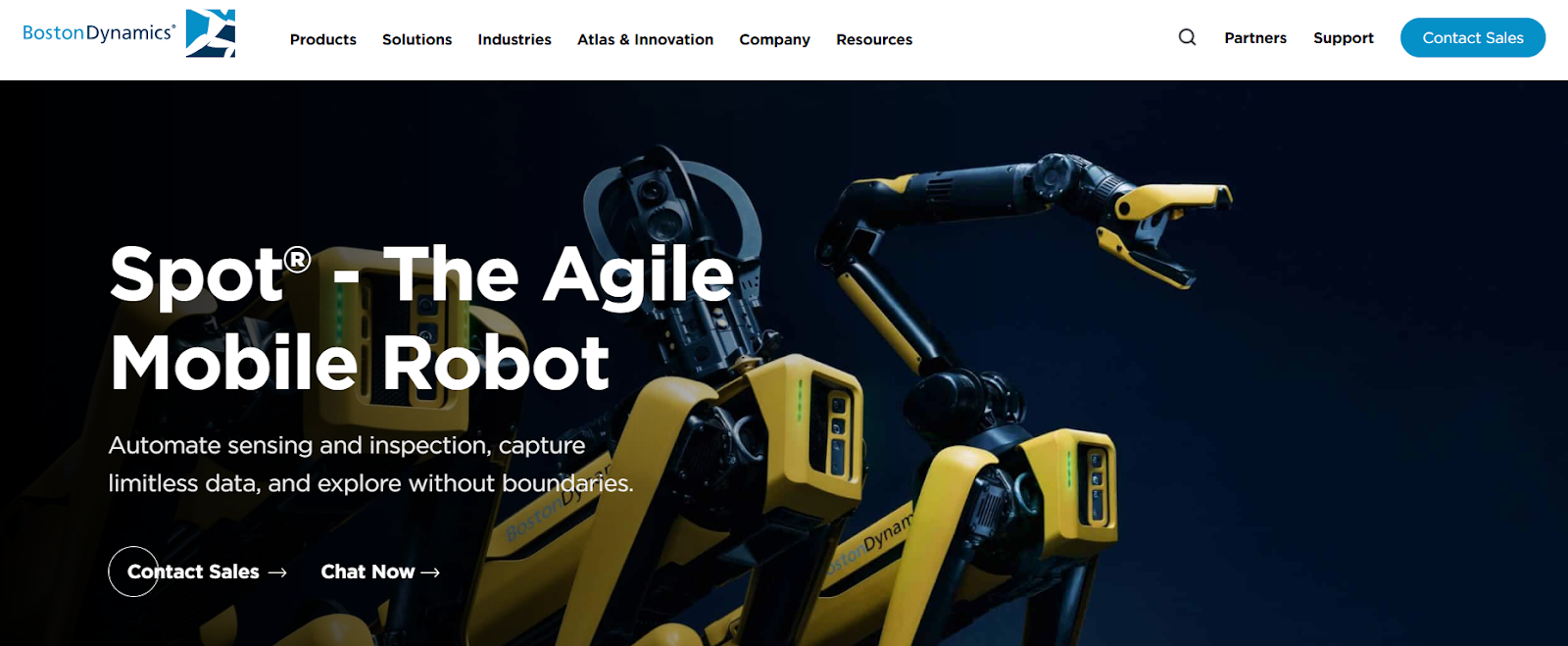
The Boston Dynamics Spot robot is a four-legged, agile mobile robot that uses advanced sensors and electric actuation to navigate complex environments. It performs automated inspections and data capture in hazardous or challenging industrial settings like factories, construction sites, and nuclear facilities.
Originally unveiled in 2016 and made commercially available around 2020, Spot is often referred to as the “robot dog.” However, while it may appear playful, it’s designed for serious work. Industries use it to monitor construction sites, map facilities, detect anomalies, and collect sensor data in hazardous or hard-to-reach areas.
Spot runs on battery power, uses stereo cameras and optional LiDAR for perception, and supports modular attachments like robotic arms and custom payloads. It’s designed to be tough, flexible, and capable of working in environments that are too dangerous or inefficient for humans to inspect manually.
Boston Dynamics Spot price: How much does it cost?
The Boston Dynamics Spot price starts at ~$75,000 for the Explorer Kit. This package includes the robot, one battery, a charger, a controller, and basic software. It is mainly intended for research labs and early-stage testing.
To make Spot useful in the field, you’ll need add-ons such as the Spot Arm for manipulation, LiDAR sensors for 360° mapping, or advanced autonomy software. With these extras, the total cost often exceeds $100,000.
Boston Dynamics doesn’t publish bundle pricing, but the base price has stayed consistent since launch. The premium reflects Spot’s industrial-grade hardware: a durable chassis, advanced navigation, and mobility unmatched by most robots.
The sales process typically involves:
- Consultation with Boston Dynamics' sales team
- Technical requirements assessment
- Custom configuration for your needs
- Training and deployment planning
- Ongoing support setup
Although Spot is technically available to anyone, it’s mainly sold to enterprises like construction companies, energy utilities, government agencies, and research institutions. Buyers must also agree to terms that prohibit using Spot for harmful or intimidating purposes, and Boston Dynamics reserves the right to refuse sales.
Spot robot specs and features
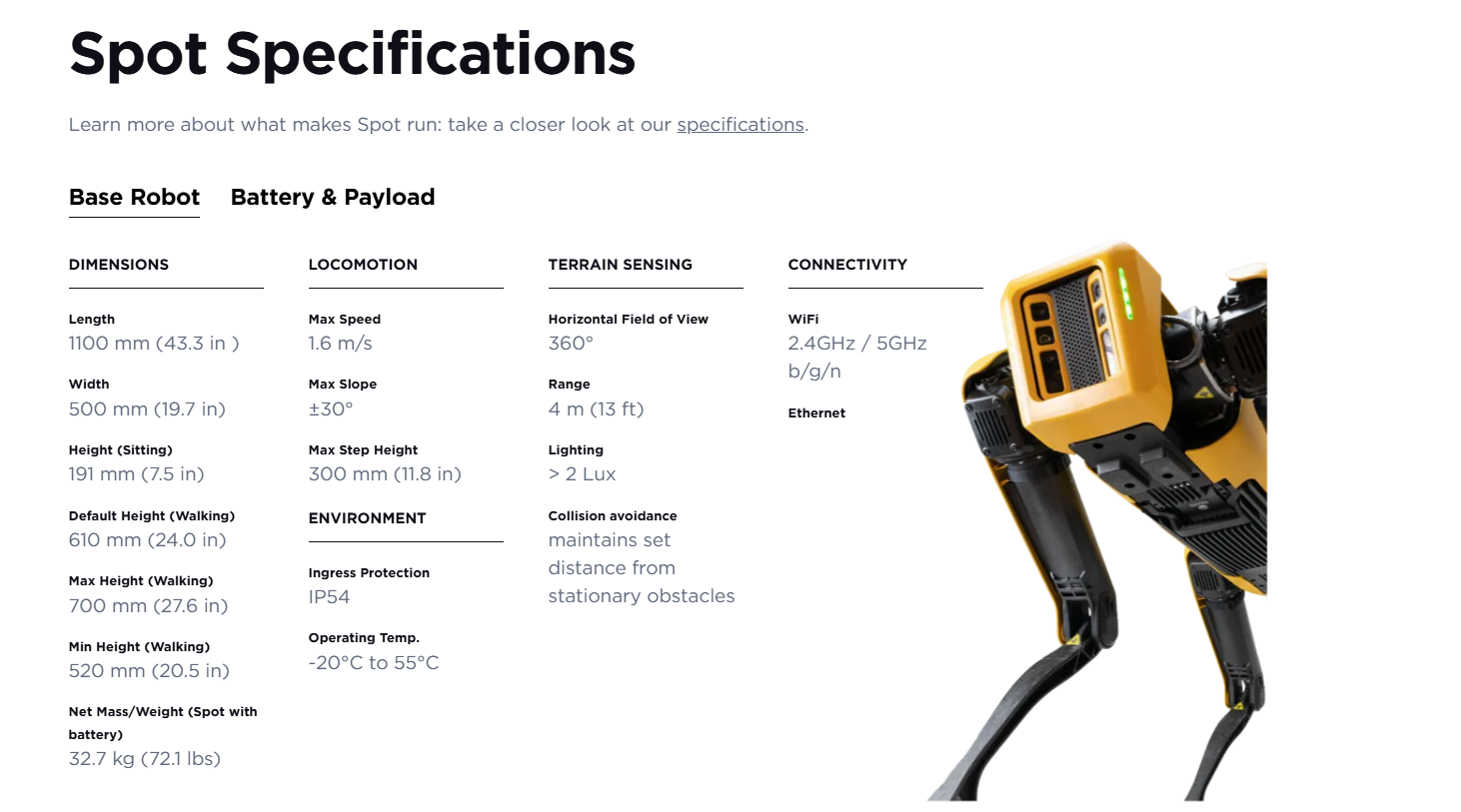
The Boston Dynamics Spot robot weighs 32.7 kg and features a 90-minute runtime per charge. It also has a maximum speed of 1.6 m/s and a payload capacity of up to 14 kg. Its size, strength, and agility make it well-suited for environments that are too cramped, unstable, or hazardous for humans or wheeled robots.
The robot uses multiple stereo cameras positioned around its body for 360° perception and depth sensing. This lets Spot avoid obstacles, climb stairs, and walk over rough terrain with impressive balance. You can upgrade Spot with a Velodyne LiDAR unit for more advanced navigation and mapping tasks.
Spot’s modular design is one of its biggest strengths. Add-on options include:
- Sensor payloads: Radiation detectors, thermal cameras, or environmental monitors
- Communication add-ons: Radios, microphones, and speaker units for remote collaboration
- Spot Arm: For manipulating objects like opening doors, turning knobs, or retrieving small items
-
- Autonomy software: Boston Dynamics’ Scout platform allows users to plan routes, schedule patrols, and review logged data
- IP rating: Spot has an IP54 rating for dust and water resistance, allowing operation in various weather conditions
- Additional specs: It can handle stairs and slopes up to ±30° and operate in temperatures from -20°C to 55°C
The robot can be operated manually using a tablet controller or programmed for autonomous missions. Developers can also build custom behaviors using the robot SDK, which supports Python, C++, and other languages through its SDK, with ROS integration available.
Spot is not designed to replace fixed industrial arms but complements them by going where static robots cannot.
What can the Boston Dynamics Spot do?
The Boston Dynamics Spot can perform inspections, mapping, safety patrols, and data collection in environments too dangerous, repetitive, or remote for humans. From climbing stairwells in power plants to scanning active construction sites, Spot works where wheels or static machines simply can’t go.

Here’s how it’s used across different industries:
- Industrial inspections: Spot can autonomously walk through oil refineries, offshore platforms, nuclear power plants, and manufacturing sites. It can also record thermal, acoustic, and visual data at set intervals. This reduces the need for human workers to enter confined, toxic, or high-voltage spaces.
Beyond early adopters Shell and National Grid, Spot is now deployed across major industrial facilities. These include BP's Mad Dog offshore platform in The Gulf for gas leak detection, Aker BP's Skarv installation in the Norwegian Sea for autonomous inspections, and Lockheed Martin's manufacturing center for material flow automation and tooling monitoring.
- Construction site mapping and progress tracking: With LiDAR and high-res cameras mounted on its back, Spot can perform full 3D scans of active construction sites. Contractors use it to monitor progress, detect changes, and maintain digital twins, freeing up workers from manual walkthroughs.
Pomerleau, one of Canada's largest construction companies, has integrated Spot into their workflow for automated site documentation and safety inspections.
- Security and surveillance: Public safety and disaster response: Spot has been deployed in collapsed buildings, earthquake zones, and radiation-contaminated areas. It can traverse rubble, search rooms, and transmit live video and sensor data without putting first responders at risk.
The NYPD briefly tested Spot in 2020–2021 for emergency response scenarios, though the program was discontinued due to public concerns about surveillance.
- Research and development: Universities and labs use Spot to study robot locomotion, test AI algorithms, or develop real-world human–robot interaction (HRI) models. Spot is fully programmable and works with SDKs like ROS, making it ideal for advanced prototyping.
Spot is a mobile platform that can be adapted to many different jobs, depending on what you mount on it and how you program it. Its flexibility makes it one of the most useful mobile robots in modern industry.
Spot vs. other robot dogs
The difference is that Spot is built for industrial use with advanced sensors, autonomy, and durability, while other robot dogs like Unitree, Aibo, or Tombot are designed for research, companionship, or therapy. Spot functions as a mobile automation tool, not a consumer gadget.
Let’s break it down:
Unitree Go2
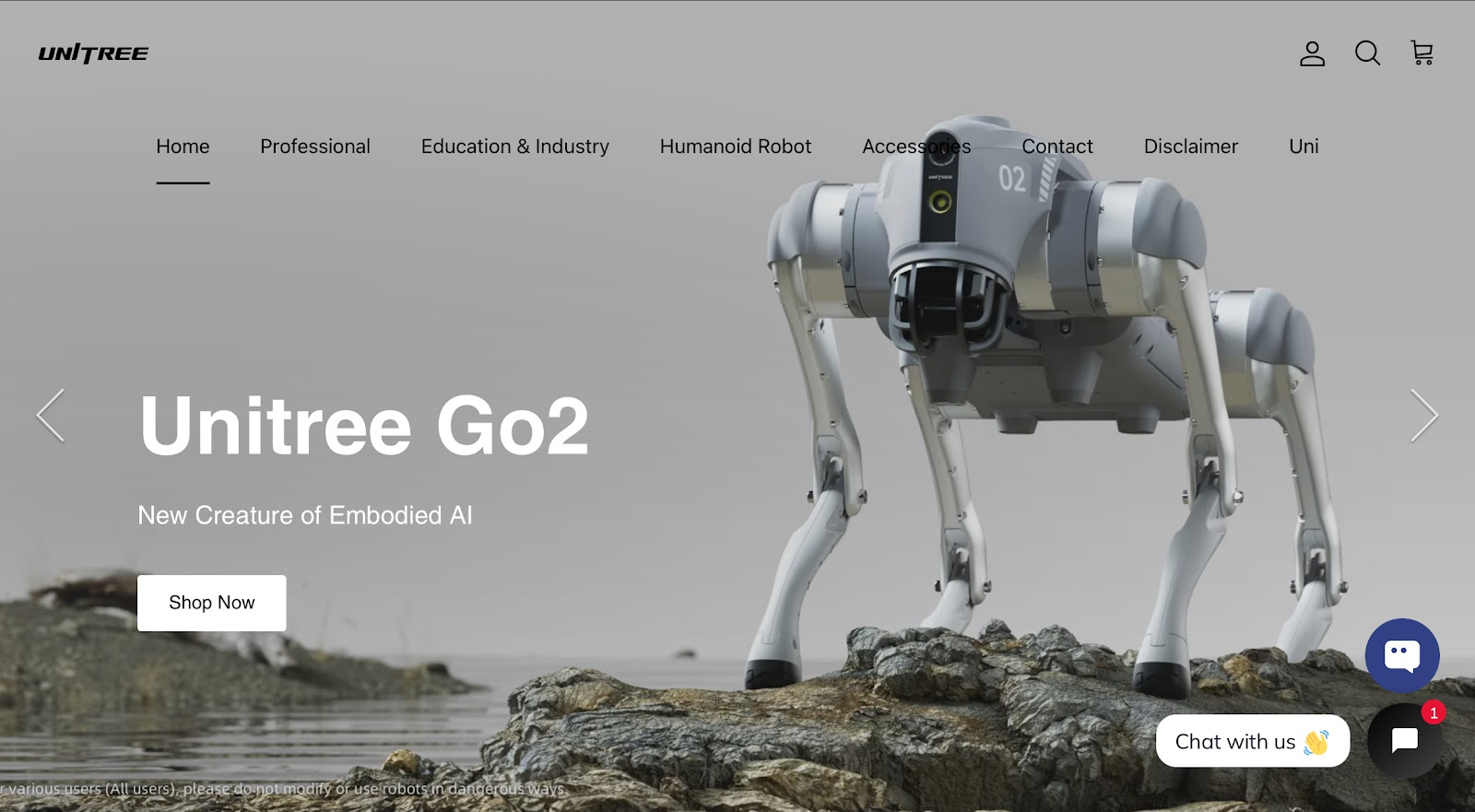
Unitree Go2 is available for $2,800, depending on the configuration. These quadruped robots are lightweight, relatively fast, and often used in robotics labs for gait research or student projects.
They support basic obstacle avoidance and can follow commands, but lack advanced features like LiDAR mapping, rugged weatherproofing, or full autonomy. They’re not designed for industrial use and require careful supervision during operation.
Sony Aibo
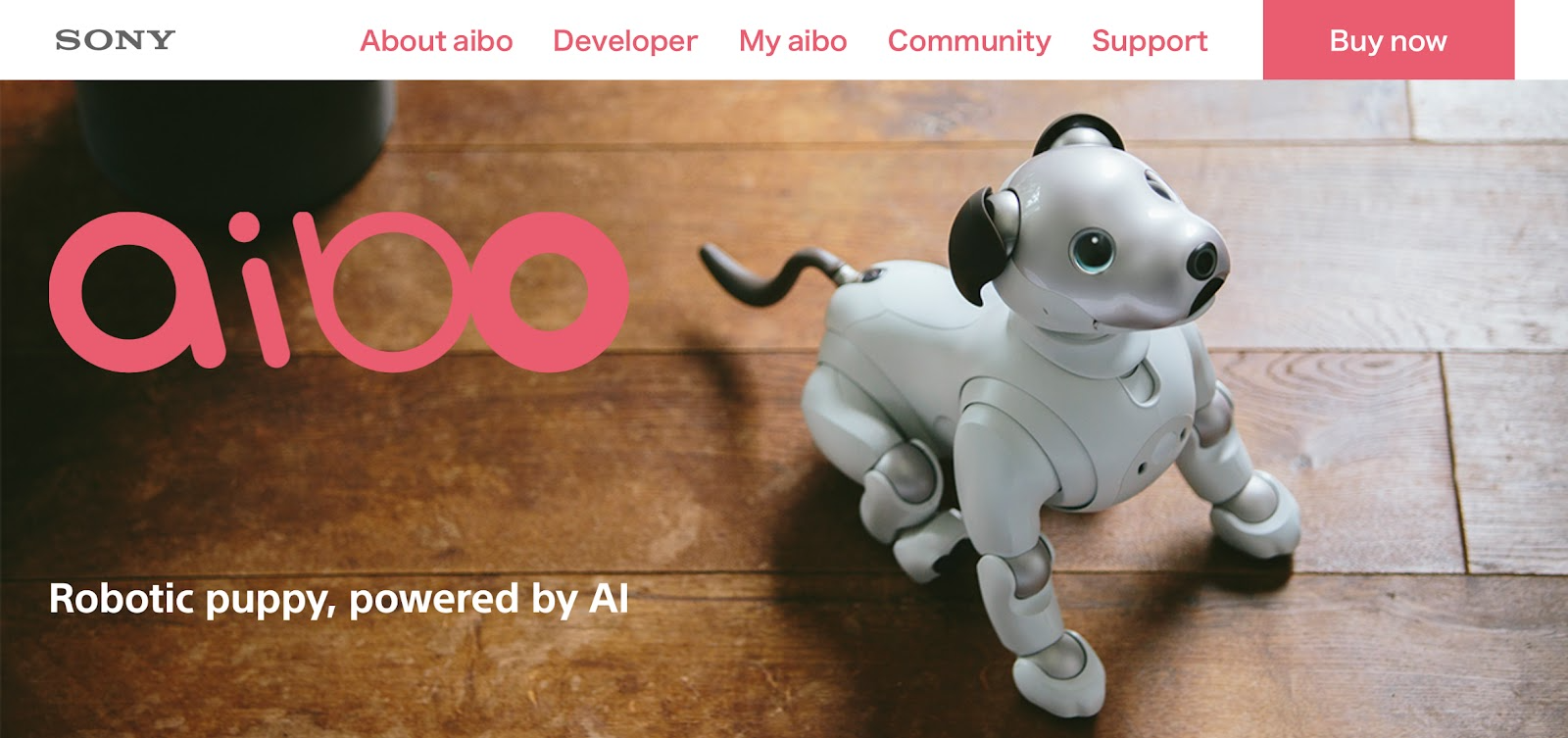
Sony Aibo, priced around $3,200, is a consumer-grade robot dog designed purely for companionship. It uses facial recognition, touch sensors, and voice interaction to respond to its owner, adapting its behavior over time.
While it’s advanced in terms of emotional responsiveness, Aibo doesn’t support external payloads, autonomy, or task-based programming. It’s built to entertain and comfort, not to perform real-world work.
Tombot Jennie
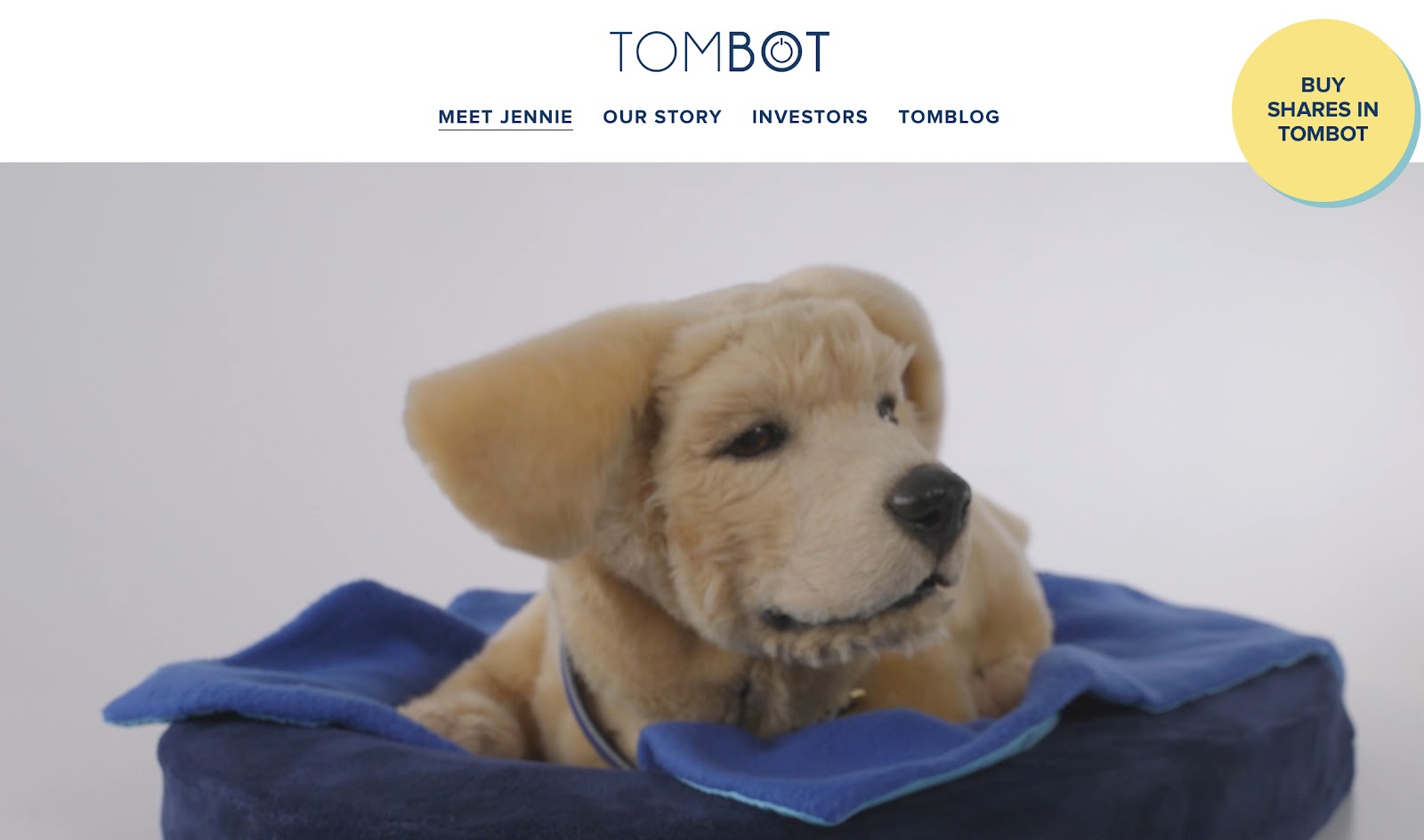
Tombot Jennie costs about $1,500 and is designed as a robotic therapy dog for seniors or individuals with cognitive conditions like dementia.
It simulates companionship with realistic movements, touch responses, and dog-like sounds. Unlike Spot, it does not include sensors, AI decision-making, or task automation. It is built purely for emotional comfort.
How does Spot compare?
Spot offers advanced features like real-time mapping, programmable autonomy, payload mounts, and enterprise-level SDKs. It is also IP-rated for weather resistance and built with high-grade materials to handle daily industrial use.
That is why Spot costs upward of $75,000 while other robot dogs fall under $5,000. Spot is closer to a mobile automation platform, while others function as interactive toys or entry-level research tools.
Challenges and criticisms
Boston Dynamics' Spot faces several challenges, like high cost, limited battery life, and growing public unease over policing uses. Smaller teams also struggle to prove ROI.
- The price is steep: Even the base model costs $75,000, and once you start adding sensors, arms, and autonomy software, it’s not unusual for the total to go beyond $100,000. For large companies, that might be manageable. For smaller teams, it’s a dealbreaker, especially if they can’t prove a fast ROI.
- Battery life is limited: Spot runs for about 90 minutes on a charge. That works fine for a planned inspection run or short demo, but not for tasks that require constant operation. You’ll either need hot-swappable batteries or charging stations to keep it going.
- Ethical concerns are growing: Spot has been tested for police surveillance and military applications, which has raised some public backlash. Boston Dynamics has strict policies against weaponizing the robot, but people still get uneasy when they see a robot dog patrolling streets.
- Some say it’s more hype than help: Not every team that buys Spot ends up using it long term. Without clear workflows, trained staff, and strong software integrations, Spot can sit idle. For those just getting into automation, a stationary system like a cobot pick and place setup might offer more value right away.
Spot clearly has potential, but it isn’t a plug-and-play fix for every company. It works best when paired with the right use case and technical support.
Summing up: Is Boston Dynamics’ Spot worth the price?
Boston Dynamics Spot costs $75,000, and its value depends entirely on the task. For enterprise inspections, construction monitoring, or disaster response, it can be a smart investment. But for smaller companies or anyone expecting a plug-and-play robot assistant, Spot might be overkill.
It’s also worth noting that Spot isn’t the only mobile robot on the market. Other solutions offer better value depending on your goals.
So is Spot worth it? If you’ve got the right job for it, absolutely. If not, you might be better off with something simpler, more affordable, or better matched to your workflow.
Next steps with Standard Bots’ robotic solutions
Looking for a smarter way to automate inspections, material handling, or pick-and-place tasks? Standard Bots’ RO1 is the perfect six-axis cobot addition to any industrial setup, delivering unbeatable precision and flexibility.
- Affordable and adaptable: RO1 costs $37K (list price). Get high-precision automation at half the cost of traditional robots.
- Precision and power: With a repeatability of ±0.025 mm and an 18 kg payload, RO1 handles even the most demanding CNC jobs.
- AI-driven simplicity: Equipped with AI capabilities on par with GPT-4, RO1 integrates smoothly with CNC systems for advanced automation.
- Safety-first design: Machine vision and collision detection mean RO1 works safely alongside human operators.
Schedule your on-site demo with our engineers today and see how RO1 can bring AI-powered greatness to your shop floor.
FAQs
1. How much does Boston Dynamics Spot cost?
The Boston Dynamics Spot starts at $75,000 for the base Explorer Kit, including the robot, battery, charger, and controller. Industrial deployments typically exceed $100,000 with add-ons like the Spot Arm, additional batteries, LiDAR sensors, and specialized software.
Final pricing requires consultation with Boston Dynamics' sales team based on specific use cases.
2. What tasks can Spot perform?
Spot can perform automated inspections, mapping, and safety patrols in environments too dangerous or remote for people. Industries like energy, construction, and manufacturing use Spot to capture thermal, acoustic, and visual data on a schedule, reducing the need for workers to enter hazardous areas.
With add-ons such as the Spot Arm, it can manipulate objects like doors or valves, making it useful for industrial automation, public safety, and even research applications.
3. How long does Spot’s battery last?
Spot’s battery lasts about 90 minutes on a single charge under typical conditions. Runtime varies depending on terrain, payload, and task complexity. For continuous operation, Boston Dynamics recommends carrying hot-swappable batteries or setting up docking stations to keep Spot active in the field for extended missions.
4. How does Spot compare to cheaper robot dogs like Unitree?
Spot differs from lower-cost quadrupeds like the Unitree Go2 ($2,800) in durability, sensors, and autonomy. Unitree robots are mainly used in labs for gait research or by hobbyists, offering basic obstacle avoidance and mobility.
Spot, on the other hand, provides enterprise-ready features such as LiDAR mapping, IP54 weather resistance, 14 kg payload capacity, and a full SDK for industrial applications. This makes Spot closer to a mobile automation platform than a toy or classroom robot.
5. Are there ethical concerns around Spot’s use in policing?
Yes, Spot’s use in policing and surveillance has raised ethical questions about privacy, accountability, and public trust.
The NYPD and other agencies briefly tested Spot for emergency response and crowd monitoring, sparking backlash and concern about “robotic policing.” Boston Dynamics prohibits weaponization, but the broader debate continues as cities weigh the balance between public safety and civil liberties.
6. Can individuals buy a Spot robot?
Individuals can technically buy a Spot robot, but Boston Dynamics primarily sells to enterprises, government agencies, and research institutions.
Consumer ownership is rare because of the price, required training, and licensing restrictions on surveillance or weaponization. Purchases usually go through a consultation process, with customization for the buyer’s specific use case.
brighter future
Join thousands of creators
receiving our weekly articles.










